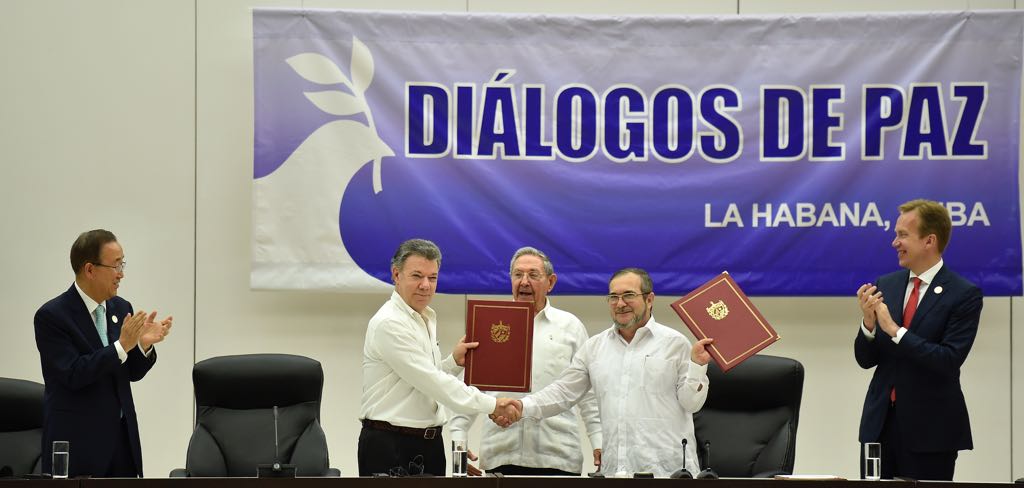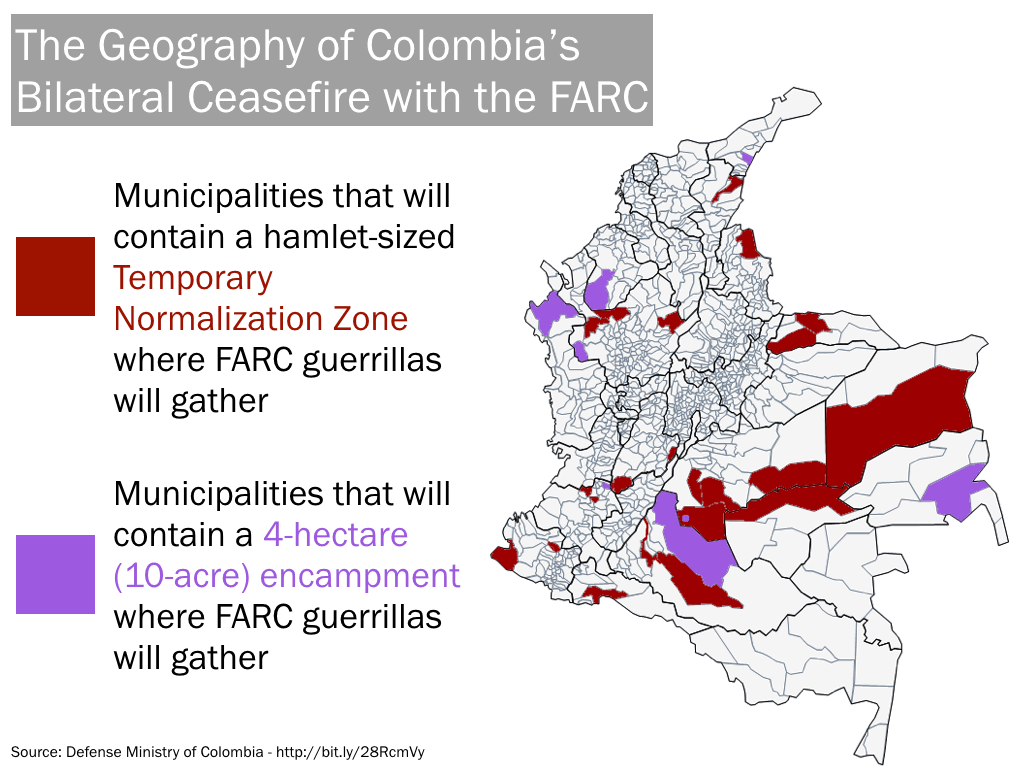Update as of 8:15PM EST: The Colombian government and FARC have issued a joint communiqué assuring that the accord “enters into force after ratification by the Congress. As a consequence, ‘D’ Day is today, according to the terms of the Accord.” This clears up much of the question, making it likely that Colombia will follow the first, and most desirable, of the three timetables discussed below. However, if Colombia’s Constitutional Court decides to torpedo “fast track” authority, uncertainty about D-Day may resume.

The vote was the substitute for a second national plebiscite on the accord. On October 2 Colombian President Juan Manuel Santos convened a national plebiscite to ratify the accord’s first version. Voters surprisingly rejected it, by a 0.5 percentage-point margin. Colombian law does not require peace accords to be approved by a plebiscite; President Juan Manuel Santos chose to take this step because a popular vote would have conferred more legitimacy on the accord, which took four years to negotiate. After the plebiscite defeat, the government and FARC made adjustments to the accord, incorporating many of its opponents’ suggestions. These adjustments did not go far enough to satisfy Uribe and other critics, who remain opposed.
The Santos government is reluctant to submit the revised accord to a second plebiscite. First, because—in this year of unpredictable election results—its passage is not assured. And second, because organizing another plebiscite would take about two months, extending the legal limbo in which the FARC’s membership finds itself and straining a fragile ceasefire arrangement.
The Colombian government and FARC disagree about what the accord calls “D-Day”: the first day in which guerrillas must begin a six month process of gathering into twenty-seven zones and turning over their weapons to a UN mission. Five days after D-Day, the accord states, all FARC guerrillas are to begin reporting to the village-sized concentration zones.
The accord appears to indicate that D-Day was the day the final accord was signed (Thursday, November 24th), but neither side is holding to that. The government believes D-Day is now: the day after the accord’s ratification. The FARC insists that its members will not begin to demobilize and disarm without a guarantee that they won’t be subject to summary arrest for having rebelled. It wants a political-crimes amnesty law, absolving all members of the crime of sedition (rebelión), to be approved first, or at least formally presented and moving rapidly through Congress. Only then, in the guerrillas’ view, will D-Day arrive. The text of that law, which the Congress must approve, is embedded in the peace accord.
Congress must approve a series of other laws to implement the accord: establishing a transitional justice system, guaranteeing protections for opposition political movements, carrying out a new rural development policy, among others. But the amnesty law is the one that must come first, since the FARC won’t even start turning in its arms without it.
In the meantime, it is dangerous to keep waiting. At present, arrest warrants against FARC members have been suspended, and a bilateral ceasefire with UN monitoring is in place. But that ceasefire is fragile, as evidenced by a November 13 combat incident in Bolívar department, which left two guerrillas dead.
Meanwhile, it is unrealistic to expect the FARC’s entire membership to remain docile in its clandestine encampments, with no certainty about their future, for a long period. During an extended “limbo,” dissidences might emerge within the group. Even if that does not happen, every day of uncertainty could see a steady trickle of FARC members abandoning their encampments, perhaps to pursue lives of criminality, no longer available when the moment to demobilize finally arrives. And even if that doesn’t happen, each day of delay is another in which other criminal groups can establish a stronger foothold in territories of historic FARC influence, increasing the likelihood of further violence. The process is unlikely to withstand much more uncertainty.
When will “D-Day” truly happen? Here are three potential timetables, depending on an upcoming decision from Colombia’s Constitutional Court, which was already reviewing challenges to the plebiscite law (the “Legislative Act for Peace” [PDF]), which the Congress passed in July. This decision could come as early as Monday, though there is no fixed timetable.
-
Congressional ratification with “fast-track” legislative authority: just a few days until D-Day. The July 2016 law establishing the plebiscite stated that if the accord is approved by “ratification by the people” (refrendación popular), the laws resulting from it may be approved with fewer rounds of congressional voting, and the possibility of passing laws in a matter of a few weeks. Colombians, borrowing from English, call this accelerated legislative process “fast track.”
The government, and its majority coalition in Congress, are likely to pursue this path now, beginning debate on the political-crimes amnesty law via fast track. The amnesty could be formally presented in Congress next week, and either approved or nearing approval by the time the current legislative session ends on December 16, which would allow the FARC to begin demobilizing. This process, though, risks being nullified by the coming Constitutional Court decision.
-
Another plebiscite with fast-track: about 2-3 months until D-Day. The Constitutional Court may decide that the fast track option is only valid after the accord’s approval by plebiscite, adopting a strict definition of “ratification by the people” to mean ratification directly, and not through the people’s elected representatives. If so, then this week’s Congressional ratification would not be enough to allow the amnesty law, and other accord implementation laws, to go via fast track.
This, in fact, is the recommendation of the ponencia—the “first draft” decision, proposed by one of the justices (in this case, the chamber’s President)—submitted on Monday. The ponencia is not the final word, and Colombian media reports indicate that a majority of justices may be in favor of revising it to maintain fast-track authority. But if the justices agree with the ponencia, then Colombia’s government might need to go through with a second plebiscite in order to preserve fast track.
The last plebiscite took a bit less than two months to organize. So if we assume a Court decision in early December, a plebiscite in February, a “yes” vote, and an amnesty law a few weeks after that, then the FARC might begin to demobilize in late February or early March. It won’t be easy, but the ceasefire, and the FARC’s command and control, might be able to withstand this delay.
It’s impossible to predict whether a second plebiscite might pass. However, one of the opposition’s strongest arguments no longer makes sense today. Many “No” voters claimed that while they weren’t opposed to peace, they wanted a better accord. Now, a new accord has been negotiated, and the likelihood of going back and negotiating a third one is zero. A second plebiscite would be a starker choice between peace and renewed war.
-
Congressional ratification without fast-track: six months to a year until D-Day. If the Court insists on a second plebiscite to enable fast track, Colombia’s government may decide not to risk a second rejection. This would leave the Congress forced to pass the amnesty law, and all other accord implementation laws, through its regular legislative procedures.
These procedures are lengthy: eight debates over many months. These debates and votes could stretch on into June or July, and the Constitutional Court’s process for reviewing them could drag on for months after that. By the second half of next year, meanwhile, Colombia will be nearing the launch of campaigning for March 2018 legislative and May 2018 presidential elections, creating a climate in which even the smallest steps toward implementation will be politicized. It’s unlikely that the ceasefire, and the FARC’s ability to maintain a large force in clandestinity without losing much of its membership, can last this long.





